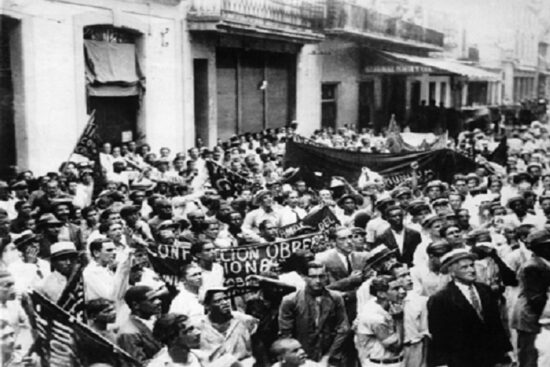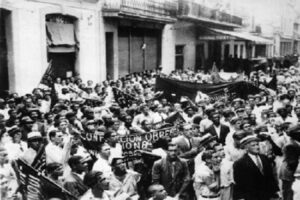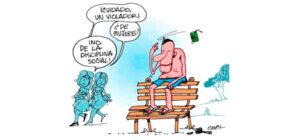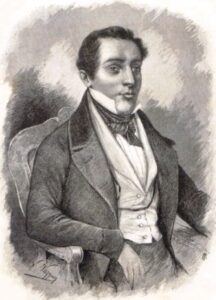The general strike that sent a dictator on the run.

09/15/1933. Cubans marching in the streets of Havana after Fulgencio BATISTA took power on September 4 (overthrowing Manuel de CESPEDES) to protest against Yankee imperialism, in other words against American interference on the island. After the BATISTA putsch, anti-Americanism spread on the island. That same month BATISTA's government repealed the PLATT amendment which had provided a judicial base for North American interference (supported by MACHADO, the former dictator and Manuel de CESPEDES who had temporarily replaced him.) Le 15 septembre 1933, dans les rues de La Havane, après la prise de pouvoir de Fulgencio BATISTA le 4 septembre (en renversant Manuel DE CESPEDES), la population cubaine défile pour protester contre l'impérialisme yankee, c'est-à-dire contre l'ingérence américaine sur l'île. Avec le putsch de BATISTA, un fort courant anti-américain s'installe dans l'île, le gouvernement de BATISTA abroge ce même mois l'amendement PLATT, base juridique de l'ingérence nord-américaine que soutenait MACHADO, l'ancien dictateur et celui qui l'avait remplacé temporairement, Manuel de CESPEDES.
T

The fall of Gerardo Machado was imminent, as even that Abela cartoon predicted. The patient would be discharged, they said to Bobo, a cardinal character of Cuban graphic humor who had become a symbol of the people in opposition to the excesses of that fateful government.
By August 7th, 1933, the general strike was spreading throughout the Republic and U.S. Ambassador Sumner Welles wrote a list of immediate solutions in one of his reports. But neither the appointment of an impartial Secretary of State, nor the reorganization of the Cabinet or the immediate approval of constitutional reforms could prevent the expected decline.
By that afternoon, 20 people had died and 170 were wounded. The Havana bus strike had been the spark for the necessary revolutionary explosion.
Followed by an unstoppable wave of strikes in different sectors of the economy throughout the island since August 4, the outbreak augured the end of «one of the most opprobrious and reactionary regimes known to the history of Cuba and Latin America», as the communist fighter of those years, Fabio Grobart, would later define it.
Down with Machado!» shouted the workers who would not return to their jobs after certain reforms, but only after the dictator resigned. Neither the people, nor the army, nor Welles himself were willing to put up with his obvious unpopularity any longer.
The general strike would be joined by the military revolt of August 11 and at noon the following day the president would be forced to flee the country in an airplane and accompanied by few friends.
During the nine years of his government he had managed to transform the initial approval of the people into deep hatred towards a president capable of reforming the Constitution in search of personal benefits.
The notable worsening of economic conditions in the country, where unemployment increased and salaries decreased in contrast to the high cost of living, had contributed to the gestation of a revolutionary situation.
To this would be added the relentless persecution of political adversaries, mass imprisonment, torture and assassinations even beyond our borders, as happened with the indefatigable leader Julio Antonio Mella.
But the tide willing to stop the injustices of the dictatorship would make the Communist Party and its most brilliant figure Ruben Martinez Villena, together with the National Confederation of Workers of Cuba (CNOC), the University Student Directorate (DEU) and the Student Left Wing starred those days of August, which would be, in the words of Raul Roa, «the most vast and powerful general strike of which our history has data».
Written by Jeidi Suárez García.




